Physical Address
304 North Cardinal St.
Dorchester Center, MA 02124
The chin plays a key role in contributing to facial balance and harmony, from ancient history through contemporary culture.
Proper head positioning in the Frankfort horizontal plane is essential for preoperative assessment.
Proper implant material selection and design achieve pleasing results with minimal complications.
Techniques are described for the submental and subperiosteal approaches to placing an extended Silastic implant.
Suggestions are presented for improving implantation technique; bone has many advantages for a dissection plane.
A review of complications, including mental and marginal mandibular nerve injury, emphasizes their prevention and management.
For centuries, a strong chin has been a desirable attribute, from ancient times to contemporary high fashion and entertainment. A look through any popular celebrity “image” magazine reveals predominantly strong chins, on both women and men. Visualize some of the major stars of movies, past and present, male and female, or national leaders. Try to imagine an Oscar winner or president with a weak chin – it is quite difficult to do so. A strong chin implies power, beauty, confidence, intelligence, success, and “strength” ( Fig. 26.1 ). A weak chin connotes submissiveness, indecisiveness, or “weakness.” Our perception of character based on particular facial characteristics dates back to Aristotle. In one study regarding facial features and military rank at West Point, men whose features were prominent – including a strong chin – were compared with submissive-looking men, who had, among other things, receding chins. Photographs alone were predictive of rank and achievement, with prominent-featured men outranking their submissive-appearing classmates in their junior and senior years, as well as later, in their profession.
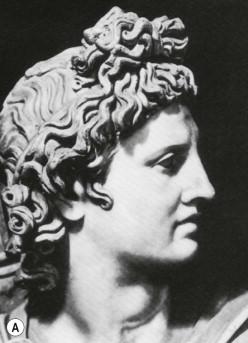
A study of idealized profiles compared with those in the general population showed that “ideal” chins are actually larger than those that occur naturally; these ideal chins, seen on beautiful people and on sculptures, are truly “larger than life.”
Classical sculptors believed than an ideally proportioned face required, among other characteristics, the chin to be projected anteriorly enough to meet their aesthetic guidelines.
Michelangelo used the Apollo Belvedere ( Fig. 26.1A ) as a model for his Christ in the Last Judgment at the Sistine Chapel, and Goethe and other leaders of the Greek Revival saw it as the perfect example of classical beauty; this Apollo was also used by Edward Angle, the father of orthodontics, in defining the ideal face.
Artists and sculptors as far back as the classical era, and possibly earlier, depicted beauty by following mathematical concepts.
The Greeks strove to envision the human body as perfectly and harmoniously proportioned; thus, for example, Plato believed that beauty required proper measure and proper size of parts fitting harmoniously into one whole.
Guidelines based on mathematics and geometry developed during classical and Renaissance periods have persisted, and have been adopted by aesthetic surgeons.
Gonzalez-Ulloa, in the 1960s, published a series of articles in which he studied profiles of “ideal” faces and applied the principles described by artists to surgical “profileplasty.” Profile analysis is based on the interrelationship of several soft tissue landmarks ( Table 26.1 ). Based on these, Gonzalez-Ulloa used two reference lines to evaluate the profile. The first was the Frankfort horizontal plane, introduced in Frankfurt, Germany, in 1884, as a reliable reference plane for standardizing the position of the face in relation to the surface of the earth. (Frankfort is often, though not always, spelled with an “o” in North American literature.) It is defined as a horizontal line from the superior border of the external auditory canal (porion) to the inferior aspect of the orbital rim (orbitale) with the patient's gaze parallel to the floor ( Fig. 26.2 ). This is considered a neutral position and should be consistent and reproducible in evaluation and photographs. The reliability of the Frankfort horizontal plane was outlined by Ricketts, who emphasized its importance in standardizing clinical communication. Professional journals require that photographs submitted for publication should be in the Frankfort plane.
| Anterior cervical line | Tangential to the vertical portion of the neck |
| Cervical point | Intersection of submentum (submental or horizontal line) and neck (anterior cervical line) |
| Facial plane | Vertical line from nasion, intersecting Frankfort plane at 90°; the ideal chin (Gonzalez-Ulloa) should approach this line |
| Frankfort plane | Horizontal line extending from porion to orbitale |
| Menton | Lowest contour point on soft tissue chin |
| Nasion | Deepest depression at the root of the nose |
| Pogonion | Most anterior point of soft tissue chin |
| Porion | The highest point on the external auditory meatus |
| Orbitale | The lowest point on the inferior orbital rim |
| Riedel's line | Connects most prominent portion of upper lip to the lower lip; the ideal chin (Riedel) should be along this line |
| Submental line | Tangential to submental area, from cervical point to menton |
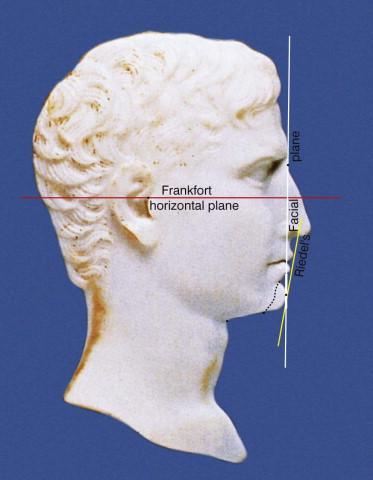
The second reference line was a vertical line (facial plane) drawn from the depression at the root of the nose (nasion), intersecting the Frankfort horizontal line at an angle of 90°. Using these two reference planes in an analysis of classically beautiful faces in art and contemporary culture, Gonzalez-Ulloa concluded that in ideal profiles the most anterior portion of the chin meets this vertical line. He adapted this concept to surgical planning. When the chin falls behind this vertical line (dashed line in Fig. 26.2 ), a chin deficiency becomes apparent and indicates that surgically augmenting the chin anteriorly would bring the profile closer to the ideal.
Other authors have suggested different guidelines for the ideal chin position. Some drop a vertical line from the lower lip, or the most anterior white roll of the lower lip. Other surgeons choose a position just behind this vertical line. Riedel suggests that the most prominent portion of the chin should be tangential to a line connecting the upper and lower lips, with the most prominent aspect of the chin on the same plane as the upper and lower lip. Because of the variability of facial structures, gender, family, and ethnic characteristics, as well as the patient's desires and surgeon's aesthetic judgment, no formula or measurement system can be followed to the letter for each and every person; it is, however, generally agreed upon that the correction for women should be less than that for men.
Harmony and beauty depend on proportional relationships between facial structures, with emphasis here on the chin's position in relation to the nose, lips, and neck. The balance of the face is influenced by alteration of any of its components. A weak chin makes the nose appear larger; augmenting the anterior projection of that chin will cause the same nose to appear smaller.
Bone and soft tissue structures of the neck also contribute to aesthetic appreciation of the profile. The hyomandibular angle is formed by the submental line (horizontal line), tangential to the submental area, intersecting with the anterior cervical line, tangential to the vertical portion of the neck. Their intersection is the cervical point.
An ideal “sculpted” neck has a sharp angulation, approaching a hyomandibular angle of 85–90°. However, if the hyoid bone is low and anteriorly located, the hyomandibular angle is made obtuse. This blunting of the hyomandibular angle created by a low anterior hyoid bone contributes to the perception of a small chin.
Redundant skin, muscle, and adipose tissue also contribute to making the hyomandibular angle blunted and not attractive. These soft tissues that define the anterior cervical line and submental line can be retracted and elevated, improving the neck angulation, with submental liposuction, face lift, and/or platysmaplasty.
A low anterior hyoid and weak chin can limit this improvement. The hyoid position cannot be changed, but chin position can be with chin augmentation. The most anterior soft tissue part of the chin is the pogonion, and the menton is the most inferior soft tissue point of the chin. By surgically augmenting the chin, shifting both these landmarks anteriorly, the submentum is lengthened and the submental line or horizontal line is made more horizontal, improving the hyomandibular angle. By creating a greater distance between the hyoid bone and pogonion, the illusion that the hyoid bone is not as anterior nor as blunting to the hyomandibular angle is achieved, and a more pleasant neck can be achieved. In analyzing results of neck sculpting procedures, it can be seen that in aesthetically pleasing necks, virtually all patients have “good” chins either from nature or surgery.
Anatomic considerations of importance to augmenting the mandible include bone, bony foramina, muscle, motor and sensory nerves, blood vessels, and skin.
The mental protuberance is the thick bone at the medial and inferior aspect of the mandibular body, with mental tubercles raised on each side. The upper border of the mandible is the alveolar part, containing alveoli for the roots of the teeth. The oblique line runs posteriorly from each tubercle along the inferior mandibular border ( Fig. 26.3A ).
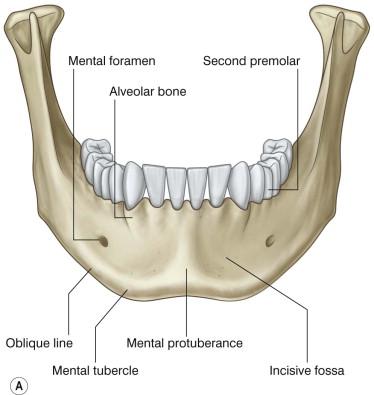
The mental foramen is a bilateral structure through which exits the mental nerve and vessels. The horizontal position of the mental foramen is variably described as inferior and slightly anterior to the second premolar tooth, or just posterior to a line drawn down from the oral commissure, or below the apex of the second premolar tooth in the midpupillary line, approximately 2.5 cm from the midline, though it may range from 1.5 to 4.5 cm from the midline. A study of 100 adult mandibles revealed the foramen to be at the level of the root of the second premolar (bicuspid) in 50%, between the first and second premolar (bicuspid) in 20–25%, and posterior to the second premolar (bicuspid) in 24%.
The mental nerve provides sensation to the skin of the chin and lower lip, as well as to the mucosa of the lip and adjacent gum ( Fig. 26.3B ). It is a branch of the mandibular nerve of the third division of the trigeminal nerve (see Chapter 1 ), running superiorly as it exits the mental foramen, surrounded by a fibrous sheath. The bony angle of the mental foramen allows the lower labial branch to run upward toward the lip, while the mental branch travels anteriorly and medially to the skin of the chin.
The muscles of the chin are the mentalis, the depressor anguli oris, and depressor labii inferioris ( Fig. 26.3C ). The paired mentalis muscle originates from the anterior mandible at the level of and below the roots of the incisors, running downward and inserting into the skin of the chin. It elevates the lower lip indirectly (its fibers do not enter the lip), draws the lower lip against the gums and teeth, and protrudes the lower lip (as in a pout). The depressor muscles originate from bone at the oblique line and insert into skin and mucosa of the lower lip and orbicularis oris muscle. They pull the lower lip downward and laterally; the depressor labii inferioris also everts the lip.
The marginal mandibular nerve, a branch of the facial nerve, provides motor innervation to the muscles of the chin and lower lip. It enters these muscles deeply on their lateral undersurface, after coursing medially under the superficial musculoaponeurotic system (SMAS) and platysma until it crosses superficial to the facial artery and vein at the medial border of the masseter muscle. Approximately 2 cm lateral to the oral commissure, it lies in the soft tissue overlying the dissection plane.
If the marginal mandibular nerve is injured during surgery, the patient is unable to perform chin muscle functions on that side. With smiling, that side of the lower lip remains up, unable to be drawn downward and laterally, and the vermilion border cannot be everted on that side. This is not apparent with the mouth at rest.
Age-related changes affect the vertical position of the mental foramen ( Fig. 26.3D ). In adults, it is midway between the upper and lower borders of the mandible. In older, edentulous patients, because of atrophy of the alveolar ridge, its relative position is nearer the superior border. Its distance from the inferior mandibular margin remains constant, at least 8–10 mm. Also with aging, bony resorption of the mandible at its inferior aspect below the mental foramen results in a depression, named the anterior mandibular groove by Mittelman.
Soft tissue changes also occur with age. A soft tissue depression, the pre-jowl sulcus, develops between the jowl and chin. This overlies the anterior mandibular groove, accentuating the pre-jowl sulcus. Atrophy of chin musculature and the alveolar ridge also contributes to less anterior projection of the chin.
The surgeon must be able to recognize a chin deficiency to be able to improve it and to know when chin augmentation is the appropriate procedure. This requires aesthetic judgment and a systematic approach, because few patients present with “weak chin” as their primary area of concern. They may think that their neck is not well defined and needs liposuction, or that their nose is too large.
Patients are often unaware of the imbalance of their own profile because they typically view themselves from the frontal view, not the profile view. Occasionally, a person will recognize their chin weakness in candid, unposed family photographs, or recognize it in others, especially if it is a hereditary feature. To appreciate a chin deficiency, the physician must consistently examine the profile, using mirrors, instant photography, digital photos, or computer imaging, and present it to the patient in such a way that the chin deficiency and its role in facial balance is understood.
The profile view is only helpful and accurate if the head is positioned consistently for evaluation and photos. The Frankfort horizontal plane described above is that consistent head position. The inclusion of the tragus is thus required in photos or the plane is uncertain. Unfortunately, it is common for the patient with a chin deficiency, excess submental fat, or low, anterior hyoid to hold his or her head in a position which is more flattering, projecting the chin anteriorly by tilting the head slightly upward ( Fig. 26.4 ). Slouching also encourages anterior positioning of the mandible. These things must be recognized, and the patient asked to sit erect without leaning back in a chair during the examination.
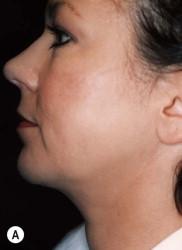
If this naturally assumed, subconscious compensatory posture is unrecognized and not addressed by the evaluating surgeon, the opportunity to improve the profile with chin augmentation may be missed.
The position of the hyoid bone and hyomandibular angle should be noted and considered, because a low, anteriorly positioned hyoid, which is not surgically correctable, may limit improvements attainable by face lift, by platysmaplasty, or submental liposuction. A chin implant improves aesthetically pleasing angles by lengthening and subsequently making more horizontal the submental line from cervical point to menton.
Muscle function should be evaluated and photographically documented with the patient smiling, as asymmetry is not uncommon.
Lip posture is assessed at rest and in animation. In patients with more severe retruded chins, dimpling of the skin of the chin often accompanies labial incompetence as the mentalis muscles “overwork,” attempting to create lip closure at rest. This is a relative contraindication to chin augmentation with implants because of a higher rate of complications (see Pitfalls and their management ).
Other notable features of the physical exam are the presence of submental scars, skin thickness, a dimple or cleft, vertical height, pre-jowl sulcus, ptosis (witch's chin), and symmetry.
Intraorally, hygiene, occlusion, and the presence or absence of teeth or dentures are documented.
Chin/mandibular implants are appropriate for patients with mild microgenia (small chin) and normal or near-normal dental occlusion, and/or a pre-jowl sulcus. Microgenia is the result of underdevelopment of the mandibular symphysis with an adequate mandible. Micrognathia is hypoplasia of various parts of the jaw with malocclusion. Patients with micrognathia, or microgenia with greater degrees of malocclusion, should be offered orthodontic or surgical correction – not chin augmentation with implants. Patients requiring more than 0.5 cm augmentation (approximately 0.8 cm anterior dimension implant) may develop complications from too large an implant; consideration should be given to horizontal osteotomy with mandibular advancement. Increased or decreased vertical height, and bony asymmetries, are also better addressed by orthognathic procedures.
A surgeon who performs cervical liposuction or other neck and face contouring procedures will enhance satisfaction by educating patients on the role of their chin in facial balance and harmony.
Implant materials used historically include paraffin, gold, silver, ivory, bone, cartilage, dermis, and fat. Unpredictable absorption, reaction, and rejection have been some of the problems that have prompted surgeons to search for predictable and safe implants.
Alloplastic materials used with documented experience include silicone, polymethacrylate (hard acrylic), porous materials such as Mersilene mesh (Ethicon, Somerville, NJ), Proplast (polytetrafluoroethylene, withdrawn from the market by the US Food and Drug Administration in 1992), Medpor (polyethylene; Porex Industries, Fairburn, GA), and more recently Gore-Tex (expanded polytetrafluoroethylene; e-PTFE, WL Gore, Flagstaff, AZ). (For general reading on implant materials see Choe and Stucki-McCormick; Romo et al.; Binder et al. )
The ideal implant material ( Box 26.1 ) should be well tolerated with a non-palpable, natural feel, be stable and resist resorption and infection, be non-immunogenic and non-carcinogenic, and be easily removed, as well as straightforward to insert and modify, flexible enough to conform to the underlying bony surface, and capable of being folded for placement through a relatively small incision.
Well tolerated
Non-palpable
Natural feel
Stable, resistant to resorption and infection
Non-immunogenic
Non-carcinogenic
Easily removed
Straightforward to insert and to modify
Flexible enough to conform to the underlying bony surface, and to be folded for placement through a relatively small incision
Silastic is solid silicone rubber, which satisfies criteria for an ideal chin implant. Silastic is flexible enough to be able to bend, allowing it to be inserted through a 2–3 cm incision. It is soft enough to suture through, to place holes, and to modify with a blade or scissors. At the same time, it is firm enough to approximate a natural feel to the chin, as its consistency is between that of hard bone and soft tissue. It maintains its shape, resisting resorption indefinitely.
A thin fibrous capsule forms around the non-porous implant; there is no tissue ingrowth as in porous implants, making Silastic easy to remove if necessary and unlikely to harbor bacteria. It is heat stable, allowing removal and resterilization if necessary. Holes are manufactured in some implants, and can be made on others, to allow fibrous tissue ingrowth for stabilization. This capsule does not distort the implant as a fibrous capsule may do to a silicone gel breast implant because the implant is solid, not gel, and is spread over bone. The capsule is even thought to help stabilize the implant to the surrounding tissues.
Design of Silastic implants has evolved and improved over the past two decades with the development of the extended mandibular implant. Formerly, implants were designed to augment the mandible in its anterior dimensions only, confined to a region between the mental foramina (thus, they are called “central” implants). This anterior-only augmentation led to the term “button” chin and, by augmenting only centrally, these implants often further deepened and accentuated the pre-jowl sulcus ( Fig. 26.5 , top, and see Fig. 26.11 ).
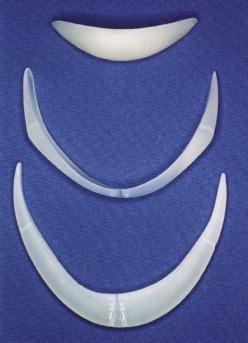
Mittelman recognized that the anatomy of the aging mandible required augmentation in the pre-jowl sulcus, the depression formed by the bony anterior mandibular groove and soft tissue atrophy in the pre-jowl region. Central implants did not extend far enough laterally to augment this area. By designing a thicker extended lateral limb in the region of the pre-jowl sulcus, his Prejowl Chin implant (Implantech, Ventura, CA) was able to address this anatomic deficiency in addition to anterior augmentation ( Fig. 26.5 , bottom).
For the patient with adequate anterior chin projection but needing pre-jowl augmentation alone to create a smoother, stronger jawline, Mittelman designed the Prejowl implant with a thin central portion, providing minimal anterior projection, with thickness confined to the pre-jowl sulcus ( Fig. 26.5 , middle). In his experience, 75% of face lift patients have a treatable pre-jowl sulcus and 40% have microgenia improvable with anterior augmentation as well. Because the pre-jowl sulcus has a bony as well as a soft tissue component, face-lift tightening of soft tissues alone is often insufficient to significantly smooth the entire sulcus; the thickening in pre-jowl sulcus of these implants helps to augment this defect.
Flowers hand sculpted implants from silicone blocks and later designed preformed extended implants with slightly softer consistency, greater flexibility, and different dimensions. He addressed the variety of angles of incline of the anterior face of the mandible, noting that an implant with a straight vertical back (as many central implants have) can cause problems in positioning. His implant, the Flowers Mandibular Glove (Implantech), has a caudal lip allowing vertical tilt, helping to create a smooth transition from implant to the non-augmented adjacent mandibular body.
Extended implants address the anatomy which results in chin and pre-jowl deficiencies; at the same time, they introduce additional considerations and features.
Dissection of a pocket to place these laterally extended implants requires care to avoid the mental and marginal mandibular nerves ( Fig. 26.6 ). The limited lateral extent of central implants does not require dissection in these danger zones. Chin Implant Style 3 (Allied Biomedical Corporation, Goose Creek, SC) has preformed cut outs on its superior aspect below the mental foramina, allowing more space (safety zone) between implant and mental nerve. Other design characteristics include fenestrations medially or laterally. These holes allow tissue ingrowth to help stabilize the implant, and the medial holes may be used as well for suture fixation. Fenestrations for tissue ingrowth and stabilization can be created by using a small (1.5 mm) trephine or punch biopsy instrument.
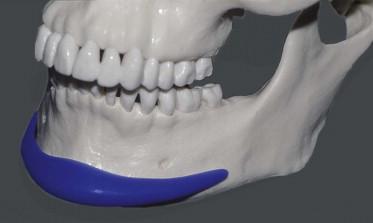
Because implants are commercially manufactured in a limited number of sizes, some modification may be performed, if necessary, on the implants. The implants may be trimmed superiorly to allow more clearance for the mental nerve, or to prevent pressure on dentures. Trimming laterally may facilitate insertion and prevents augmenting the jowl itself if a significant portion of the implant extends beyond the pre-jowl sulcus. Care must be taken to smoothly taper the lateral wings when trimming, as sharp edges may result in extrusion. Another method of shortening an implant is to remove a central portion and to suture the two remaining halves together. This can give an implant the same length, as if trimmed bilaterally, while preserving the thin tapers of the lateral edges. A pre-jowl implant can be sewn to a pre-jowl chin implant to provide additional pre-jowl augmentation without additional anterior projection.
To add augmentation to an already manufactured implant centrally only, a Glasgold Wafer (Implantech), a 2 mm disc without lateral extensions, can be positioned underneath the implant and sutured to the implant with non-absorbable sutures. If any uncertainty exists regarding size, the smaller implant is inserted, and if necessary, a wafer added. This avoids the time and additional surgical manipulation when using sizers.
Two surgical approaches have been utilized for placing a chin/mandibular implant – the intraoral (transoral) and submental (extraoral). Because a submental incision is used in neck contouring procedures such as liposuction, platysmaplasty, and often in face lift, it will be discussed here. The intraoral technique is described elsewhere. Its primary advantage is that there is no external incision; disadvantages include more difficult placement of extended implants laterally under the mental nerve, and more difficult suture fixation to the inferior border of the mandible. A review of over 100 cases of adverse events after chin implant augmentation stated, “almost all chin implant problems that the senior author has seen were caused by implants placed transorally.” Training and experience of the surgeon certainly also contribute to choice of approach.
The scar from the submental approach usually heals well and is inconspicuous, since it is on the underside of the chin and not visible from the front or side.
Anesthesia may be accomplished in a variety of manners. If the surgeon and patient choose intravenous sedation or general anesthesia, 1–2% lidocaine with 1 : 100 000 or 1 : 200 000 epinephrine is infiltrated by injecting through the skin with a 30-gauge 1-inch needle in a perpendicular manner to bone and periosteum, along the soft tissue adjacent to the periosteum, and skin and subcutaneous tissue at the incision line.
If the patient is to be sedated orally, or not sedated at all, a bilateral mental nerve block may be administered prior to local infiltration.
Prior to surgical prep, the midline is marked on the chin and submental area across the proposed incision. The position of the mental foramen may be marked after locating it by intraoral palpation at the base of, or anterior or posterior to, the second premolar, approximately halfway down the mandible.
The incision is made in the submental crease, or slightly posterior to it. Because the incision and resulting scar is so well hidden, it is not necessary to minimize the incision. A longer incision will provide better exposure, facilitate implant insertion, and allow the periosteal elevator to remain on bone when it advances laterally as the mandible curves posteriorly. A 2–3 cm incision is carried through skin and subcutaneous tissue to the mandible. The periosteum is exposed, then incised horizontally with the blade, and a subperiosteal plane developed superiorly with a Freer periosteal elevator. The bony surface should be clearly seen ( Fig. 26.7 ). The feel and sound of the elevator on bone should be present during the entire dissection of the pocket. When superior pocket elevation has reached 1.5 cm or the labiomental sulcus, a Joseph periosteal elevator is used to develop the lateral pocket along the inferior border of the mandible ( Fig. 26.8A ). The non-dominant hand is essential to externally palpate the elevator, guiding it and providing feedback that it is indeed hugging the inferior mandibular border, avoiding the mental nerve and not levering upward into the overlying soft tissues.
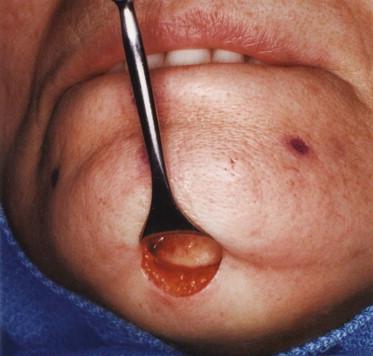
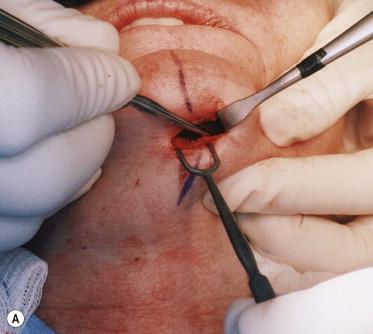
The mental foramen and nerve lie 1.5 cm superior to the inferior mandibular border in younger patients. In the aging mandible, 8–10 mm of distance remains. Therefore, the width of the elevator should be 8 mm in an older patient to avoid injury to the nerve (up to 1 cm in younger patients). The implant should have a height of 6–8 mm in this area. The superior border of the implant may be trimmed with scissors if necessary.
Opinion is divided regarding the necessity to visualize the mental nerve and foramen. Terino recommends an Aufricht fiberoptic light retractor for direct visualization to prevent injury. On the other hand, if the dissection is carefully guided using knowledge of anatomic landmarks (palpation and marking of the mental foramen), staying on bone, and on the inferior mandibular border (and not below it) at all times, it may not be necessary to visualize the mental nerve and foramen. Using these principles, and the non-dominant hand, the lateral dissection may proceed without direct visualization of the developing pocket.
The lateral extent of the pocket is judged by knowing the dimensions of the implant. Most extended lateral implants have a posterior surface 9–12 cm long, so the lateral dissection must at least be 4.5–6.0 cm on either side of the midline. The pocket should be made slightly larger, around 5 mm, than the dimensions of the implant to accommodate it comfortably.
A sizer implant can be placed on the skin to give a close idea of the size and extent of the pocket ( Fig. 26.9A ), keeping in mind that the thickness of the skin and anterior dimensions of the implant will require a more laterally extended pocket on bone than is apparent from marking around an implant placed on skin. Before placing an implant, the pocket is examined using an Aufricht retractor for any bleeding or irregularities. A gentamicin solution in which the sizers and implant are placed is then used to generously irrigate the pocket. Sizer implants may be used to assess the adequacy of the pocket, and the appropriate size of implant for the patient. Sizers are manufactured in identical sizes to the permanent implants, and are intended for insertion, inspection, and then removal once the ideal size has been chosen. It must be kept in mind that in the supine position, the mandible retracts. A jaw thrust can advance the mandible for better size assessment. Local anesthesia may also distort the volume of the soft tissue of the chin; minor adjustments must also be made for this.
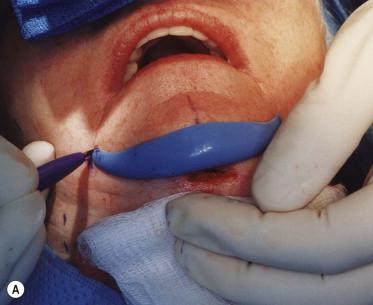
The procedure for inserting a sizer ( Fig. 26.9 ) is identical to that of inserting the permanent implant (with suture fixation following insertion for the permanent implant).
One limb of the sizer/implant is grasped with an Adson dressing forceps and directed through the incision into the far-side pocket, exposing and opening the pocket with the Aufricht retractor ( Figs 26.8B , 26.9B ). When it has been advanced as far as it can go, the middle of the implant is grasped with a hemostat or Adson forceps near the midline and stabilized. This maneuver helps keep the first side from slipping out of the incision while the second side is inserted. When both ends are in their respective lateral pockets, the center of the flexible implant may still be buckled outside the incision. The center can be pressed down toward the bone, pushing each tip outward toward the full lateral extent of the pocket ( Figs 26.8C , 26.9C ).
After an implant has been placed, it should lie flat without lifting away from bone, which would indicate too small a pocket, or ends misplaced in soft tissue irregularities, preventing full lateral extension along the bony surface. To assure that the ends are not folded, curled, or in a “false tunnel,” a flat elevator can be advanced laterally above and below the implant to unfold it.
Next, the midline marker of the implant is aligned with the midline previously marked on the skin. If no midline marker is on the implant, the midline must be marked on the implant with a notch prior to insertion. Once its midline position is established, the implant should be stabilized in at least two places. One 5-0 Vicryl (polyglactin 910) suture is placed on each side of the midline ( Fig. 26.8D ), either through prefabricated holes, or by placing the curved needle directly through the implant. This is sutured to the inferior cuff of periosteum and soft tissue. For all implants, the inferior aspect of the overlying soft tissues is incorporated in the closure with inferior periosteum to cover the implant. The remainder of the deep tissue and muscle is closed with 6-0 Vicryl in two layers and the skin closed with a suture of choice. Steri-Strips (3M, St Paul, MN) are applied over the closure and the chin is covered in a sling or hammock-like dressing with Steri-Strips or Elastoplast (Johnson & Johnson, New Brunswick, NJ) tape, left on for 3–5 days.
Become a Clinical Tree membership for Full access and enjoy Unlimited articles
If you are a member. Log in here